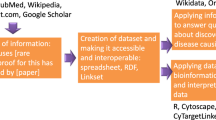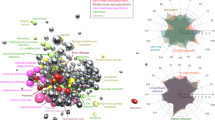Abstract
Medical genetic conditions are often known by a confusing array of synonyms, acronyms and eponyms that frequently distort historical accuracy. Expert working groups offer recommendations on preferred names, but no formal international nomenclature committee exists for this purpose. We argue that a preferred single term should be used to refer to any particular condition, and propose that this term be known as the 'orthonym'.
This is a preview of subscription content, access via your institution
Access options
Subscribe to this journal
Receive 12 print issues and online access
$189.00 per year
only $15.75 per issue
Buy this article
- Purchase on Springer Link
- Instant access to full article PDF
Prices may be subject to local taxes which are calculated during checkout

Similar content being viewed by others
References
Shows, T. B. et al. International System for Human Gene Nomenclature (1979). Cytogenet. Cell Genet. 25, 96–116 (1979).
Hall, C. M. International nosology and classification of constitutional disorders of bone (2001). Am. J. Med. Genet. 113, 65–77 (2002).
Huntington, G. On chorea. Med. Surg. Reporter 26, 320–321 (1872).
Waters, C. O. Practice of Medicine Vol. 2 (ed. Dunglison, R.) 312 (Lee & Blanchard, Philadelphia, 1842).
Harper, P. S. Huntington's Disease 2nd edn (Saunders Co. Ltd, London, 1996).
Von Recklinghausen, F. D. Ueber diemultiplen Fibrome der Haut und ihre Beziehung zu den multiplen Neuromen (Hirschwald, Berlin, 1882).
NIH Consensus Development Conference Statement (1988). Neurofibromatosis. Arch. Neurol. 45, 575–578 (1988).
Huson, S. M. & Hughes, R. A. C. The Neurofibromatoses (Chapman & Hall, London, 1994).
Meryon, E. On fatty degeneration of the voluntary muscles [Report of the Royal Medical & Chirurgical Society, Dec 9, 1851]. Lancet 2, 588–589 (1851).
Emery, A. E. H. & Emery, M. L. H. The History of a Genetic Disease. Duchenne Muscular Dystrophy or Meryon's Disease (Royal Society of Medicine Press Ltd, London, 1995).
DiGeorge, A. M. Congenital absence of the thymus and its immunological consequences: concurrence with congenital hypothyroidism. Birth Defects Orig. Artic. Ser. IV, 116–121 (1968).
Sedlác̆ková, E. Insuficience patrohltanového závĕru jako vyvojová porucha. Cas. Lék. Cesk. 94, 1304–1307 (1955).
Sedlác̆ková, E. The syndrome of the congenitally shortened velum. The dual innervation of the soft palate. Folia Phoniatr. 19, 441–450 (1967).
Turnpenny, P. D. & Pigott, R. W. Deletion 22q11 syndrome: acknowledging a lost eponym as we say farewell to an acronym. J. Med. Genet. 38, 271–272 (2001).
Jakob, A. Uber ein der multiplen sklerose klinisch nahestehnde erkrankung des zentralnervensystems (spastische pseudosklerose) mit bemerkenswerten anatomischem befunde. Mittelung eines vierten falles. Medizinische Klinische 17, 372–376 (1921).
Creutzfeldt, H. G. Uber eine eigenartige herdförmige erkrankung des zentralnervensystems. Zietschrift für die gemaste Neurologie und Psychiatrie 57, 1–18 (1920).
Knight, R. in Clinical Neurology. (eds. Swash, M. & Oxbury, J.) 825 (Churchill Livingstone, Edinburgh, 1991).
Hecht, F. & Beals, R. K. 'New' syndrome of congenital contractural arachnodactyly originally described by Marfan in 1896. Pediatrics 49, 574–579 (1972).
Beals, R. K. & Hecht, F. Congenital contractural arachnodactyly: a heritable disorder of connective tissue. J. Bone Joint Surg. A 53, 987–993 (1971).
Asperger, H. Die 'Aunstisehen Psychopathen' im Kindesalter. Archiv fur Psychiatrie und Nervenkrankheiten 117, 76–136 (1944).
American Psychiatric Association. Diagnostic and Statistical Manual of Mental Disorders (DSM-IV) 4th edn (APA, Washington, 1994)
Kanner, L. Autistic disturbances of affective contact. Nervous Child 2, 217–250 (1943).
Miller, J. N. & Ozonoff, S. Did Asperger's cases have Asperger disorder? A research note. J. Child Psychol. Psychiatry 38, 247–251 (1997).
Mayes, S. D., Calhoun, S. L. & Crites, D. L. Does DSM-IV Asperger's disorder exist? J. Abnorm. Child Psychol. 29, 263–271 (2001).
Harper, P. S. Naming of syndromes and unethical activities: the case of Hallervorden and Spatz. Lancet 348, 1224–1225 (1996).
Morrison, P. J. Naming of syndromes. Lancet 348, 1662 (1996).
Shevell, M. Naming of syndromes. Lancet 348, 1662 (1996).
Jacoby, R. & Oppenheimer, C. Naming of syndromes. Lancet 348, 1662 (1996).
Isaacs, D. & Fitzgerald, D. Acronymophilia: an update. Arch. Dis. Child. 83, 517–518 (2000).
Schrander-Stumpel, C. T. R. M. What's in a name? Am. J. Med. Genet. 79, 228 (1998).
Burn, J. Closing time for CATCH22. J. Med. Genet. 36, 737–738 (1999).
McKinlay Gardner, R. J. What's in a name? Am. J. Med. Genet. 84, 178 (1999).
Wuyts, W. et al. Molecular and clinical examination of an Italian DEFECT 11 family. Eur. J. Hum. Genet. 7, 579–584 (1999).
Balderston, D. 'Whitman: The Problematic Orthonym'. (Paper presented at the Convention of the South Central Modern Language Association, New Orleans, 1st November, 1986).
Watson, J. D. & Crick, F. H. C. Molecular structure of nucleic acids: a structure for deoxyribose nucleic acid. Nature 171, 737–738 (1953).
Davis, S. D., Schaller, J. & Wedgewood, R. J. Job's syndrome. Lancet 1, 1013–1015 (1966).
Raspe, R. E. Singular Travels, Campaigns and Adventures of Baron Munchausen (Cresset Press, London, 1785).
Asher, R. Munchausen syndrome. Lancet 1, 339–341 (1951).
Acknowledgements
We thank R. Pigott who championed the case of Eva Sedlác̆ková and thereby brought these issues to our attention.
Author information
Authors and Affiliations
Corresponding author
Related links
Related links
DATABASES
LocusLink
OMIM
congenital contractural arachnodactyly
congenital fibrosis of the extraocular muscles
Dunnigan-type familial partial lipodystrophy
Emery–Dreifuss muscular dystrophy
spondyloepimetaphyseal dysplasia Strudwick type
spondyloepimetaphyseal dysplasia with joint laxity
FURTHER INFORMATION
Human Gene Nomenclature Committee
International Federation of Human Genetic Societies
World Health Organization's International Classification of Disease Codes
Rights and permissions
About this article
Cite this article
Turnpenny, P., Smith, R. Of eponyms, acronyms and ... orthonyms. Nat Rev Genet 4, 152–156 (2003). https://doi.org/10.1038/nrg997
Issue Date:
DOI: https://doi.org/10.1038/nrg997
This article is cited by
-
Who ever heard of 16p11.2 deletion syndrome? Parents’ perspectives on a susceptibility copy number variation syndrome
European Journal of Human Genetics (2020)
-
On eponyms and disease: Dupuytren’s or Dupuytren?
European Journal of Plastic Surgery (2020)



